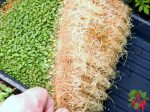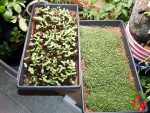This post contains affiliate links. If you buy something from one of our links we may earn a commission. Thanks

Are you thinking about growing microgreens? Want an answer to the question of can you use lettuce for microgreens?
The answer is a definite yes and we will help you learn more about how to grow lettuce microgreens in your home.
Lettuce Microgreens Key Takeaways:
- Utilizing lettuce for microgreens is a splendid choice due to its ease of growth, quick germination, and the nutritious punch it provides.
- These tender baby greens are harvested just after the sprout phase, providing a mild, versatile flavor perfect for salads, sandwiches, or garnish.
- The simplicity of growing lettuce microgreens, coupled with the nutritional benefits of vitamins A, C, K, iron, potassium, and magnesium, makes it an attractive endeavor for gardeners of all levels.
We will talk about lettuce microgreen benefits and how to grow microgreens, growing medium and trays, when to harvest and how to store your microgreens.
Can You Use Lettuce For Microgreens?
Yes, lettuce can be grown as a microgreen. Many varieties of lettuce can be used for microgreens, including romaine, butterhead (Bibb), and oakleaf lettuces.
Lettuce is one of the most versatile vegetables around. Not only does it taste great in salads, but you can also use it to grow lettuce microgreens indoors.
Lettuce can also be used to grow baby salad greens. These are larger than microgreens but still considered baby plants.
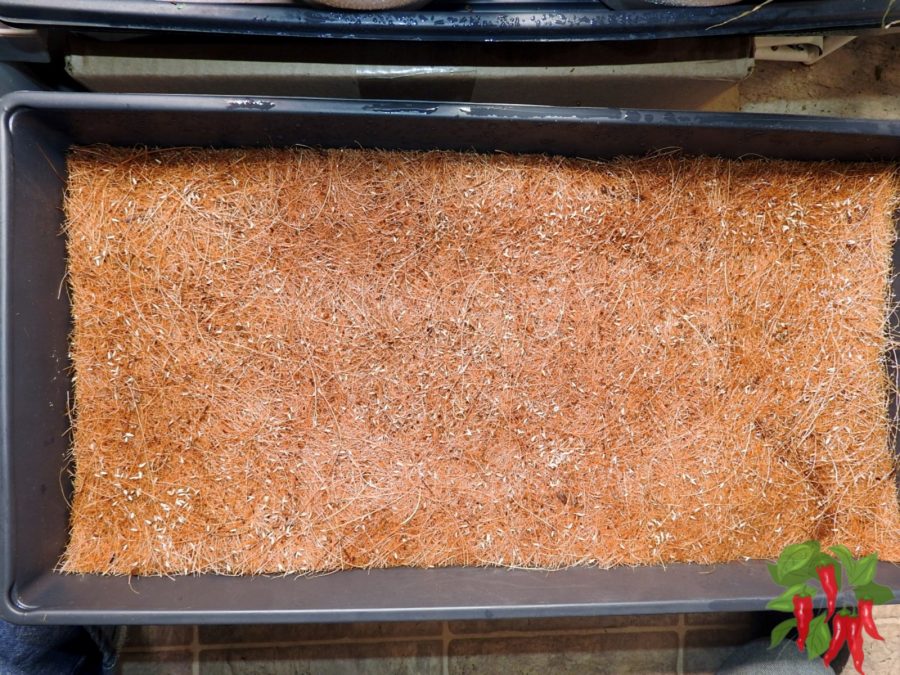
Here is some lettuce seed on a coco grow mat inside a 1020 seedling tray. It will be covered in a warm spot until germination.
Lettuce Sprouts
I placed the tray on top of a 90-gallon aquarium that is kept at 76 degrees so it works just like a heat mat. Here it is 3 days later.

My plan is to harvest microgreens selectively at first. My ultimate goal is to leave some plants to grow as baby lettuce greens.
Baby greens are a couple of weeks older than microgreens but they have the advantage of producing multiple harvests.
Lettuce Microgreens At 7 days
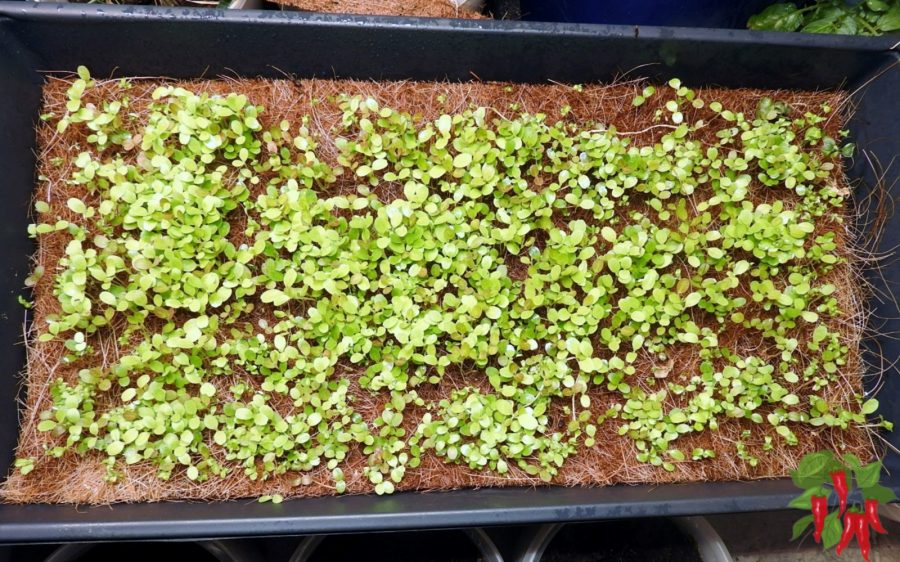
So here are my lettuce microgreens at 7 days from germination. In another week I will begin to selectively harvest them.
Eventually, I will end up with a tray of larger lettuce greens. Here’s a quick video:
Lettuce Microgreens At 13 days
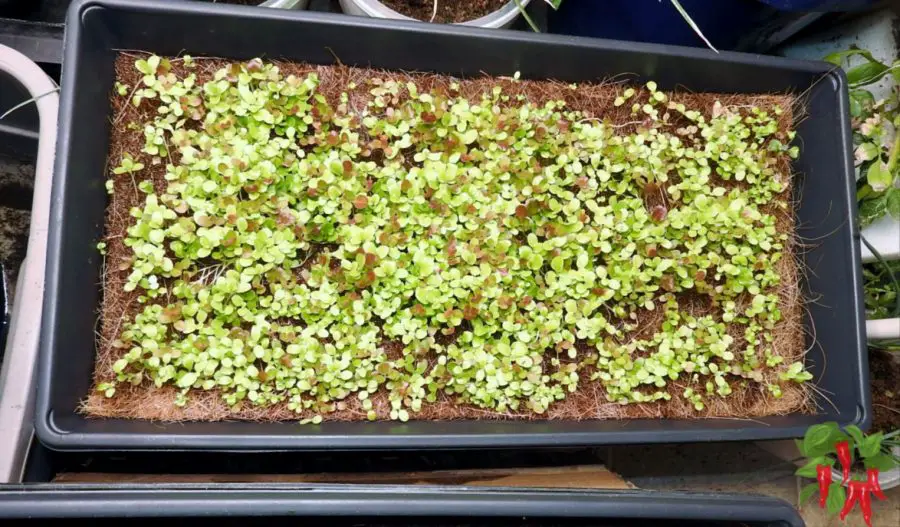
Here are my lettuce microgreens about a week later. I will start to thin them out in about a week.
The thinnings will be used as microgreens. I want to thin them out to about 4 inches apart and continue to grow them as baby greens.
What Are Microgreens?
Microgreens are a type of baby plant that is harvested when they are still very young.
They have a milder flavor than full-grown greens and are perfect for adding to smoothies, salads, and sandwiches.
Microgreens are more mature than sprouts. Growing sprouts are lacking green leaves and are grown in water and not soil like microgreens. They are also less nutritious than microgreens.
Lettuce is an excellent source of vitamin A, vitamin C, vitamin K, and iron. It’s also a good source of potassium, magnesium, and folate.
If you’re looking for a nutritious and tasty way to boost your health, give lettuce microgreens a try.
Best Varieties Of Lettuce Microgreen Seeds
Yes, lettuce can be used to grow microgreens. It is one of the most popular types of microgreen seeds for home growing because it has a mild flavor and is easy to grow. It also matures quickly.
Microgreens are typically grown in soil or other mediums such as coconut coir and grow mats. Some people even use paper towels to grow microgreens, but it is much trickier to do.
I like using coco grow mats because they are easy to store and much less messy than soil.
Also, microgreens grow very well in them.
Most varieties of lettuce can easily be used to grow microgreens, although some varieties are better suited to the process.
Generally, leaf lettuce will be more nutritious than crisphead lettuce like the Iceberg lettuce you find in the store. Colored or darker-leafed varieties are typically higher in nutrition.
 You can grow buttercrunch which is semi-heading but lettuce microgreens will be harvested long before they can head up.
You can grow buttercrunch which is semi-heading but lettuce microgreens will be harvested long before they can head up.
How To Grow Lettuce Microgreens Indoors In A Nutshell
Here is an overview of what you need to grow microgreens at home. Below is a video showing me seeding lettuce microgreens on a coco grow mat.
Microgreen Growing Trays
• To get started growing your own microgreens from lettuce seeds, prepare a potting mix or seed-starting soil growing medium and put it in your microgreen growing trays.
• Sow the seeds heavily over the surface of the soil. I prefer the 1020 seedling tray to use as a seed tray for containers although there are shallower trays available.
• Recycled food containers can also be used as a growing tray as long as they are fairly shallow and you clean them well.
• You can cover the seeds with a light layer of additional potting mix or compost, or just lightly press them into the soil. Then keep the soil consistently moist by misting it regularly.
Light
• Place the container in a sunny location like a windowsill. In the winter you will need to put them under a grow light and within a few days, you should see sprouts start to appear.
• Harvest your lettuce microgreens when they are about 2 -3 inches tall for best results. Enjoy your freshly grown microgreens in salads and other dishes.
Pests
Pests are very rare because these plants are harvested very young. Your soil mix should not contain any pests.
Root rot caused by overwatering can be a problem. Damping off can occur if you use a dome but is rare if the dome was sterilized before use. You don’t want that.
Can Lettuce Be Grown As A Microgreen?
You can definitely use lettuce for microgreens. It is one of the most popular types of microgreen seeds grown thanks to its mild flavor and easy growing conditions.
Furthermore, it provides a variety of colors, flavors, and textures when harvested as microgreens.
Growing your own microgreens from lettuce seeds can be a fun and rewarding experience that will give you access to fresh and nutrient-dense greens all year round.
So go ahead and try your hand at growing lettuce microgreens.
You can also purchase already pre-packaged lettuce seed mixes specifically designed for microgreen production.
These mixes typically include several types of lettuce, such as romaine, butterhead, arugula, and oakleaf lettuce varieties.
I purchased a looseleaf blend from Burpee seeds that includes Black Seeded Simpson, Lollo Rossa, Red Salad Bowl, Royal Oak Leaf, and Salad Bowl.
I will be growing them using coco grow mats.
The combination of different types of lettuce seeds provides an interesting variety of colors, flavors, and textures when they are harvested as microgreens.
What Are Lettuce Microgreens And Why Should You Grow Them?
Microgreens are a type of vegetable seedling that is harvested after the sprout stage, usually when they reach 2-3 inches in height.
So microgreens are a type of baby green that is harvested when they are still very young. They have a milder flavor than full-grown greens.
They are also more nutritious and are perfect for adding to smoothies, salads, and sandwiches.
Microgreens Vs Sprouts
People often confuse microgreens and sprouts but they are not the same.
Microgreens seeds are more mature than sprouts. Sprouts are lacking green leaves and are grown in water and not soil.
They are also less nutritious than microgreens due to not having true leaves.
Lettuce microgreens are particularly popular because they can be grown quickly and easily indoors or outdoors, with minimal maintenance, making them an ideal choice for both novice and experienced gardeners.
They can be used in salads and sandwiches, as garnishes, or even on their own as a side dish.
Lettuce microgreens are high in antioxidants, vitamins A and C, calcium, iron, magnesium, and potassium.
They also contain phytochemicals that have been shown to possess anti-inflammatory and immune system-boosting properties.
What Are The Benefits Of Growing Lettuce Microgreens?
There are many benefits to growing lettuce microgreens.
• They are incredibly fast-growing, with some varieties being ready to be harvested in as little as a week.
• They require very little space and can be grown indoors or outdoors, making them an ideal option for urban gardeners.
• Lettuce microgreens are also incredibly nutritious: they contain high levels of antioxidants, vitamins A and C, calcium, iron, magnesium, and potassium.
• They also contain phytochemicals that have been shown to possess anti-inflammatory and immune system-boosting properties.
• Lastly, they are incredibly versatile; they can be used in salads and sandwiches, as garnishes, or even on their own as a side dish.
What Is The Best Way To Grow Lettuce Microgreens?
 The best way to grow lettuce microgreens is to start with high-quality seeds.
The best way to grow lettuce microgreens is to start with high-quality seeds.
You will want to use fresh seeds for good germination because lettuce seeds are only viable for about 2 years.
The seeds should be planted in a well-draining soil mix and kept moist (but not wet)Continue to water until germination occurs.
The soil can then be covered with a paper towel to help retain moisture. I like to place an empty tray on top of mine and remove it when the seeds start to sprout.
Once the plants have reached 2-3 inches tall, they can be harvested and enjoyed!
Growing Tips
It is important to note that growing microgreens from lettuce requires the use of quality soil and adequate light.
Potting soil is usually peat-based and is not as good a product for micro greens as coco coir for growing lettuce indoors.
Microgreens should be watered regularly, but not too much, as they are susceptible to root rot.
Adding some compost or a bit of fertilizer can help ensure the microgreens receive all the nutrients they need to grow healthy and strong. Again not too much.
Finally, it is important to harvest your lettuce microgreens when they are in their prime, typically after 7-14 days of germination.
How To Grow Lettuce Microgreens Indoors
Although microgreens can be grown outdoors most of us will probably be growing them indoors.
Growing lettuce microgreens is a simple and rewarding process. First, select high-quality seeds from your local garden center or online retailer.
Then, prepare the soil by mixing it with compost or other organic matter to ensure good drainage.
I prefer coco coir to soil mixes and microgreen growing mats made from coco or jute work really well too.
Next, spread the seeds evenly over the top of the soil and cover lightly with a dome, paper towel, or tray.
Start watering the seeds thoroughly by misting them and keep them moist until germination has occurred (this usually can take up to 5 to 10 days).
Once the seedlings reach 2-3 inches in height, they are ready to be harvested and enjoyed!
For best results, it is important to harvest microgreens on a regular basis to ensure optimal taste and nutrition.
How To Store Lettuce Microgreens?
Lettuce microgreens should be stored in the refrigerator, preferably in an airtight container, to preserve their freshness and flavor.
To extend their shelf life, you can line the bottom of the container with a damp paper towel or cloth before adding the microgreens.
The microgreens should last for up to a week if stored properly. To ensure optimal flavor and nutrition, it is best to use the lettuce microgreens as soon as possible after harvesting.
If they are not used within a few days, the flavor and nutritional content will begin to diminish. Enjoy your delicious lettuce microgreens while they are fresh.
What To Do With Your Lettuce Microgreens When You’re Done Growing Them?
Once your lettuce microgreens are fully grown, you can use them in a variety of recipes.
They make an excellent addition to salads, sandwiches, wraps, and tacos. You can also enjoy them as a microgreen salad, a side dish or garnish on soups or other dishes.
Additionally, they can be blended into smoothies for added nutrition and flavor.
You Cant Regrow Them
If there is one disadvantage to growing microgreens it is that they are a one-and-done crop. Microgreens don’t grow back. There are a few that might regrow but lettuce is not one of them.
Once you cut the tops off there is no way for lettuce to regrow since there are no leaves for photosynthesis.
It is also best to use fresh soil each time to avoid diseases. Potting mix should never be reused.
Coco coir could be sterilized in a hot oven and reused but I don’t recommend it.
Lettuce Microgreen FAQs
Diving into the world of lettuce microgreens is both exciting and filled with questions.
Below, you’ll find a list of commonly asked questions that garden enthusiasts often have as they venture into growing these tiny, nutritious greens.
Q. What are the best varieties of lettuce for microgreens?
A. Some excellent varieties for microgreens include romaine, butterhead (Bibb), oakleaf, and looseleaf blends such as Black Seeded Simpson, Lollo Rossa, and Red Salad Bowl.
These varieties provide a mix of textures and flavors, enriching your microgreens experience.
Q. How do you grow lettuce microgreens indoors?
A. Start by selecting high-quality seeds and prepare a growing medium like soil or coco coir in a shallow tray.
Sow seeds heavily over the surface, lightly press them in, and keep the medium moist.
Place in a sunny location or under a grow light. In about 7-14 days post germination, when they reach 2-3 inches in height, they are ready for harvesting.
Q. How do you store harvested lettuce microgreens?
A. Store harvested lettuce microgreens in an airtight container in the refrigerator.
For extended freshness, line the container with a damp paper towel. It’s ideal to consume them within a week of harvesting to enjoy the optimal flavor and nutritional benefits.
Q. Can you regrow lettuce microgreens after harvesting?
A. Unfortunately, lettuce microgreens do not regrow after harvesting. It’s a one-and-done crop, as cutting off the tops leaves no foliage for photosynthesis, essential for plant growth. It’s advisable to start with fresh soil and seeds for each new crop to maintain healthy growing conditions.
Can Lettuce Be Grown As A Microgreen? Final Thoughts
The process of growing lettuce microgreens is simple and easy, making it a great choice for beginner gardeners.
Lettuce is an excellent source of vitamin A, vitamin C, vitamin k, and iron. It’s also a good source of potassium, magnesium, and folate.
If you’re looking for a nutritious and tasty way to boost your health, give lettuce microgreens a try.
With the right environment, quality soil, and adequate light, you can be harvesting nutrient-dense lettuce microgreens in no time.
So get ready to enjoy your own freshly picked greens year-round. You can do it!
Lettuce is a great plant to use for microgreens. It germinates quickly, grows easily, and has a mild flavor that pairs well with many dishes.
If you’re looking for an easy way to add some greens to your next meal, give growing lettuce microgreens a try!






